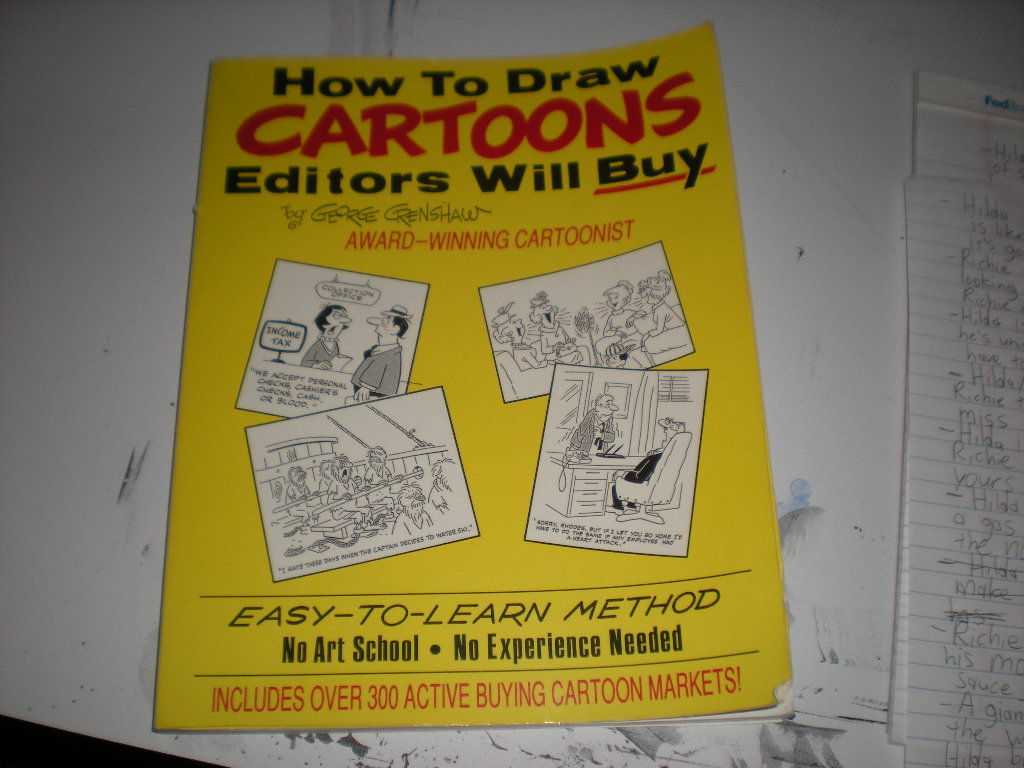I’ve got another book review today and it’s somewhat different from other books I’ve reviewed. It’s a title by the late George Webster Crenshaw (1913-2007) called How to Draw Cartoons Editors Will Buy.
This book was featured on the Small Press Comics FAQ page, as a part of their bookshelf page. I’ve mentioned this page earlier on the blog for a big reason. In addition to being a handy guide, the FAQ creator also coined something he called “M’s Law” which goes like this – any substantial book on how to draw cartoons will be written by an artist you never heard of before, whose own art is particularly average and uninspiring. However, that is NOT the case with George Crenshaw. If any of you readers out there are familiar with newspaper comic strips, you’ll probably recognize him as the creator of Belvedere, a newspaper gag cartoon which ran for over thirty years. But that’s just the start of his credentials. There’s a whole page listing his impressive credentials. He was an animator for both Disney and MGM, he drew cartoons for various magazines, and even “ghosted” (worked without being credited) on Dennis the Menace! If that’s not an impressive resume, I don’t know what is. Anyway, let’s talk about the book itself.
The text is mainly concerned with the gag cartoon as seen in various newspapers as well as magazines (such as Playboy, the New Yorker, etc). Crenshaw talks a little bit about his own career and a (very) brief history of gag cartooning. He then goes on to talk about earnings for cartoons, the style, developing technique, setting up a reference file for images, writing gags, submitting cartoons, and marketing yourself and your work.
His method of teaching you how to draw is a bit different from other books. Rather than having diagrams or step-by-step instructions on how to draw the body, the head, eyes, and such, Crenshaw advocates tracing. Yes, in the text, he recommends assembling single panel cartoons from sources, studying them, and then tracing over them to learn. There’s nothing wrong with this method and it can be a boon in helping to learn drawing. Plus it’s a welcome change of pace from other books that simply use the “draw like this” approach.
The marketing and promotion parts of the book are worth their weight in gold. On top of that, it is obvious Crenshaw believes in his methods – his text exudes a confidence that can get you fired up as well.
For all the good things about this book, there are a few problems with it. First, the emphasis of the book is on gag cartooning for magazines and newspaper. Anyone hoping for instruction or who draws in a realistic, superhero style may be disappointed. Second, this book is currently out of print. You won’t find this on the shelves of your friendly neighborhood bookstore. You’ll have to check used bookstores, flea markets and garage sales for copies of the book. Used copies can also be hunted down online through Amazon, Ebay, etc. The third problem with this book is that some of the information is outdated. The copyright date is 1991, making the book over twenty years old. The back of the book lists a directory of publications that buy cartoons. This information is most likely inaccurate all these years later as they’ve probably since then have folded, changed addresses or may no longer be accepting new material. If you want to make use of this book, you’ll probably have to use the Internet as well as updated directories like Artist’s Market in order to sell your cartoons.
Despite the book showing its age, How to Draw Cartoons Editors Will Buy is still worth getting. Even if magazine gag cartoons aren’t your cup of tea, some of the advice in here can be handy. The enthusiasm and confidence of Crenshaw is also a plus with this book; he has walked the walk and talked the talk. Hunting down this book is worth it.
How to Draw Cartoons Editors Will Buy by George Crenshaw, Paramount Press, 1991, ISBN 0962861405

